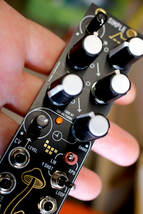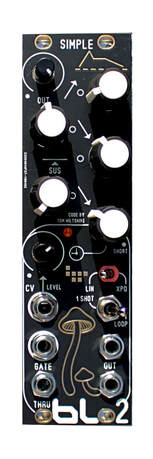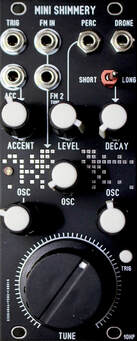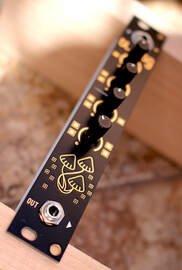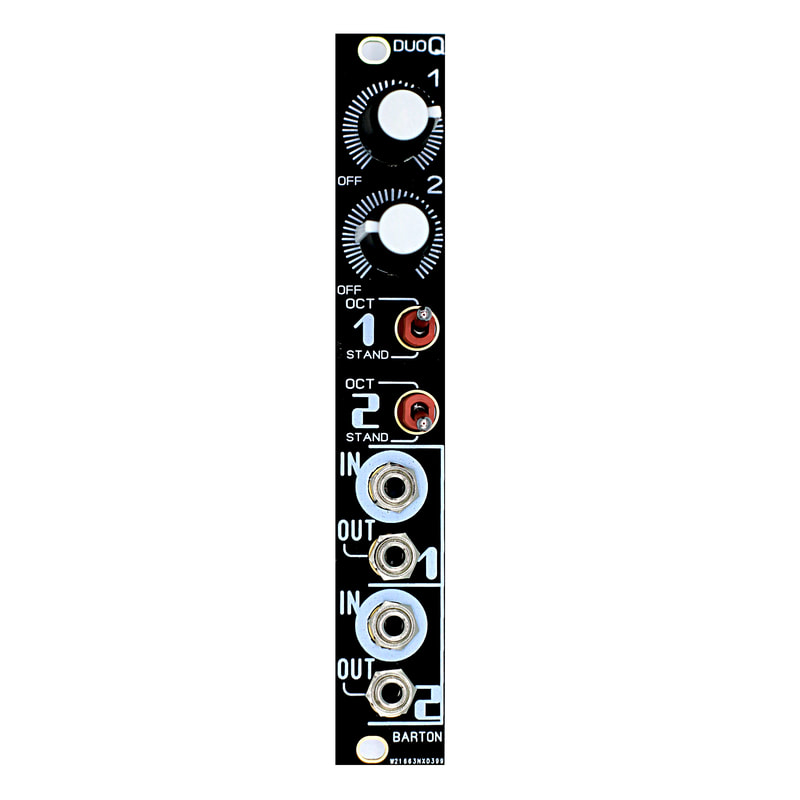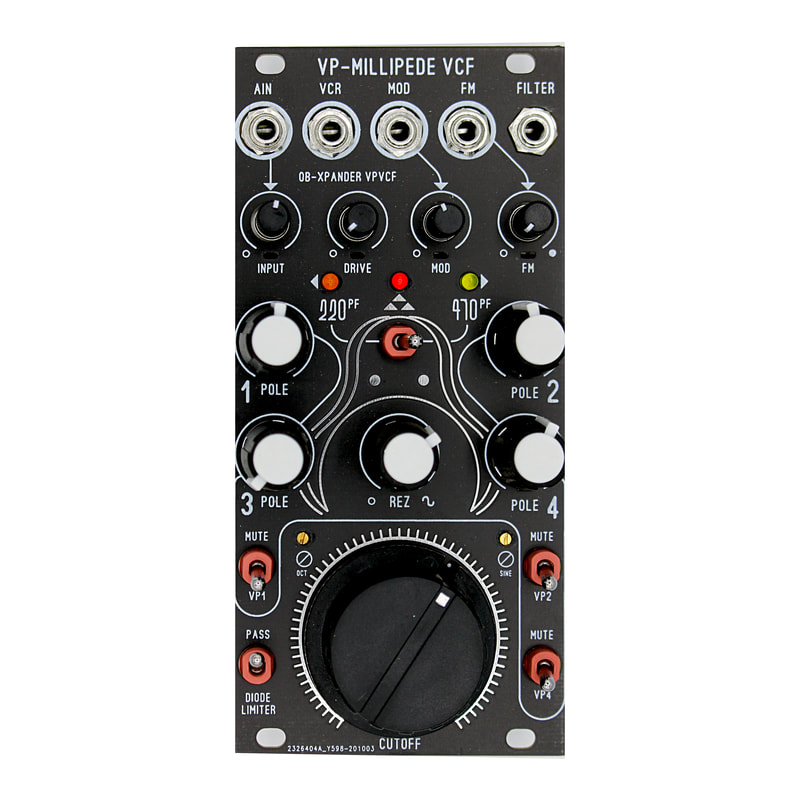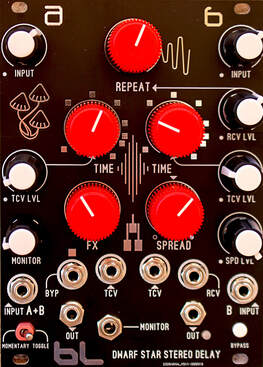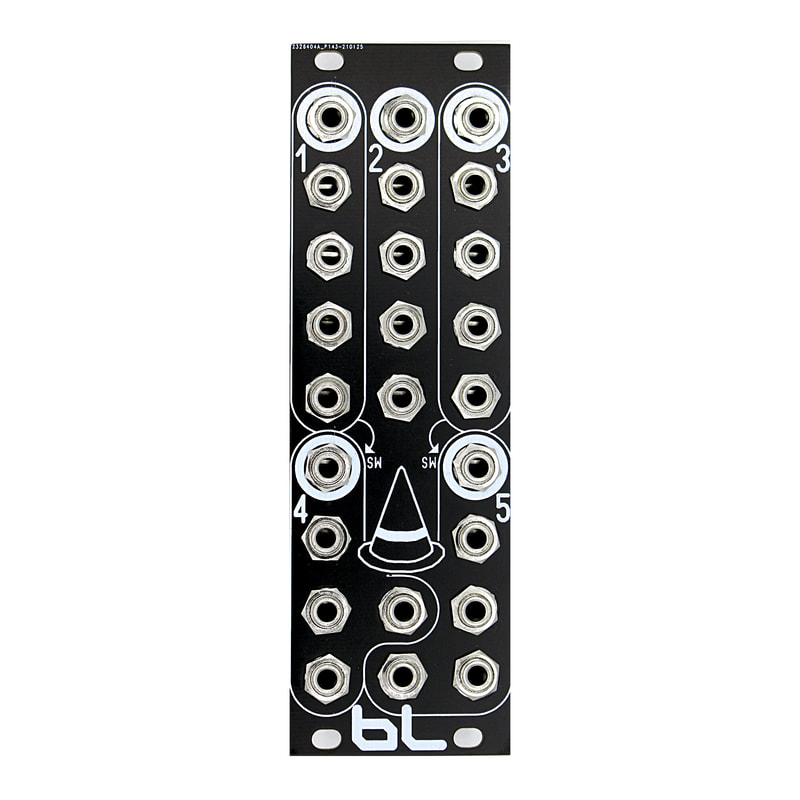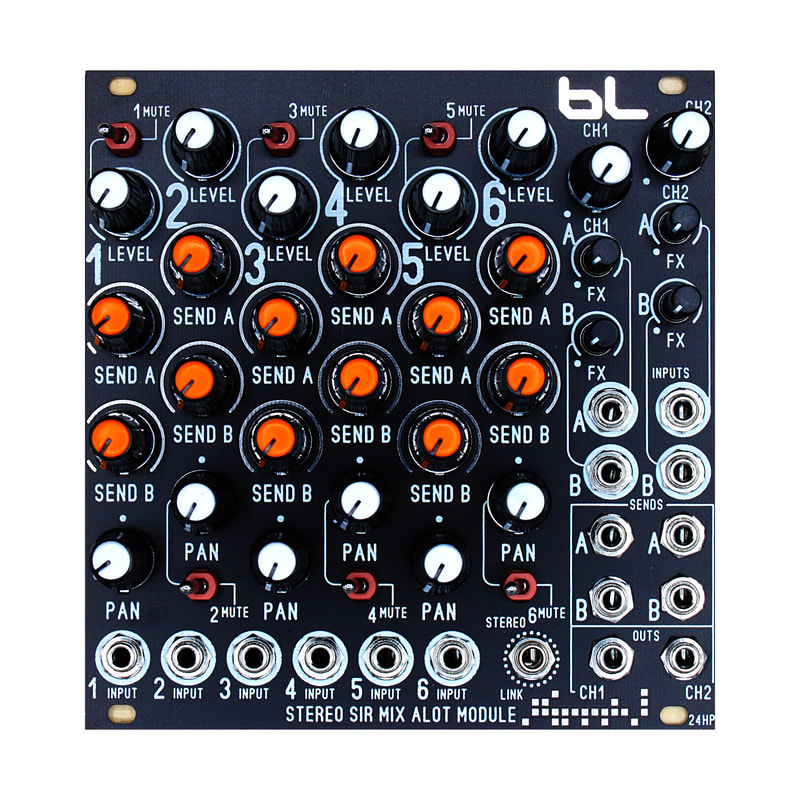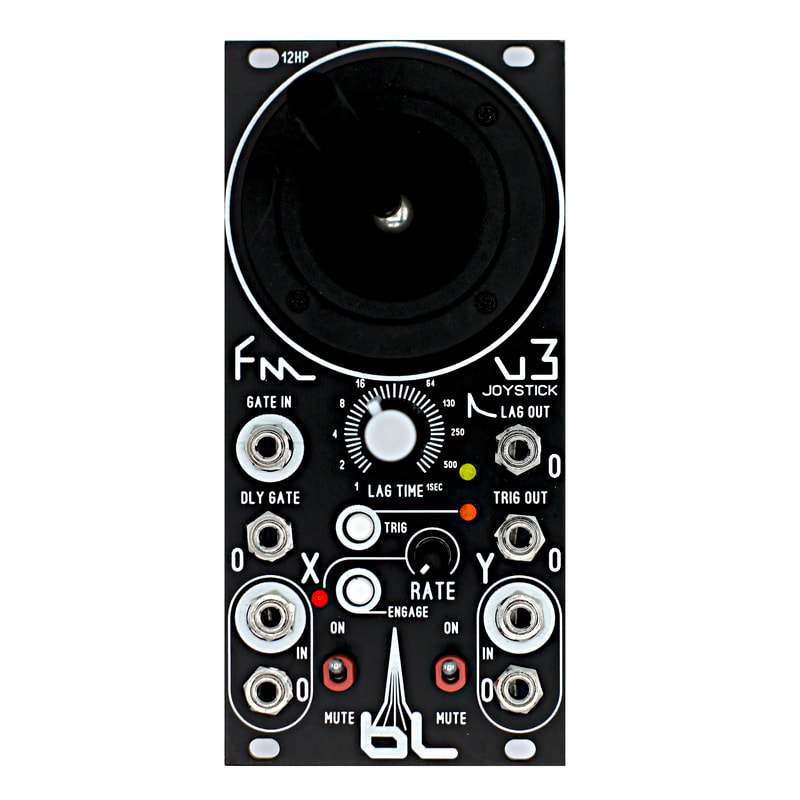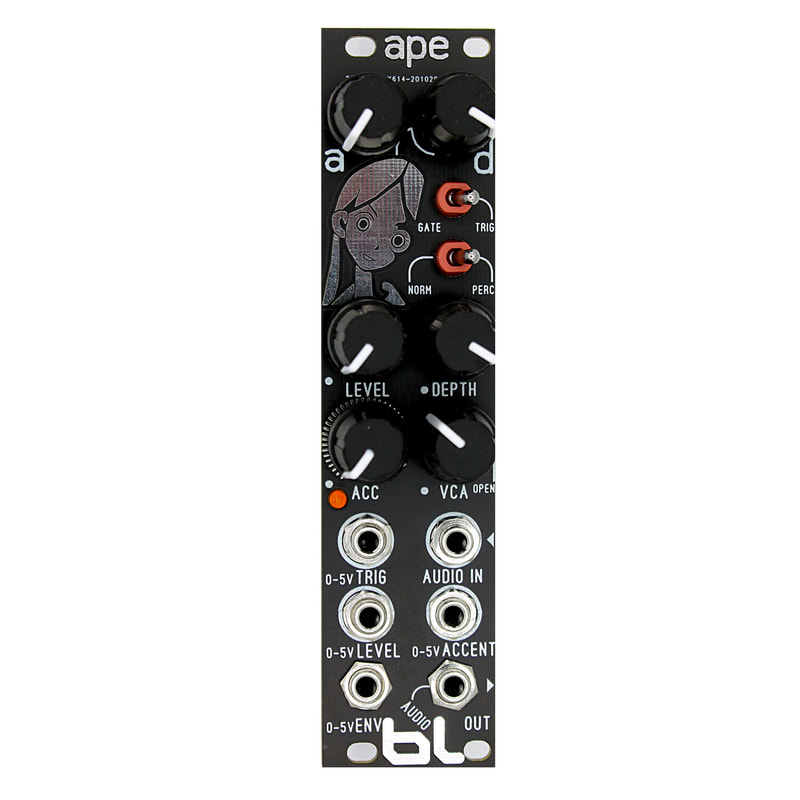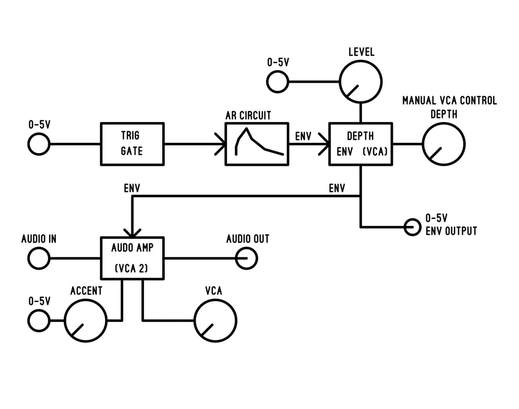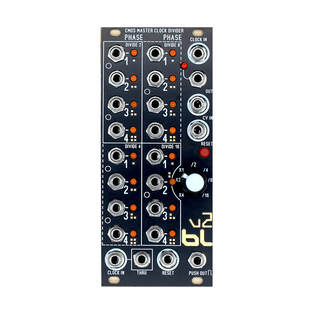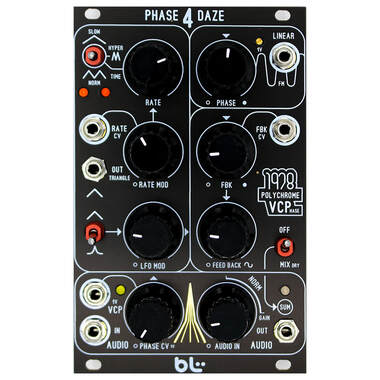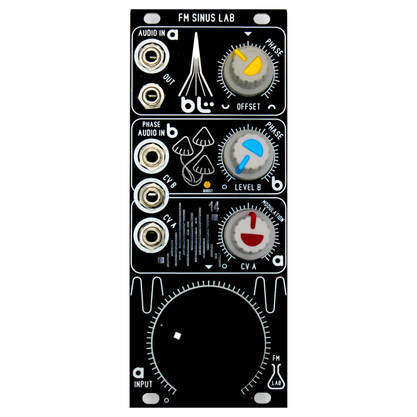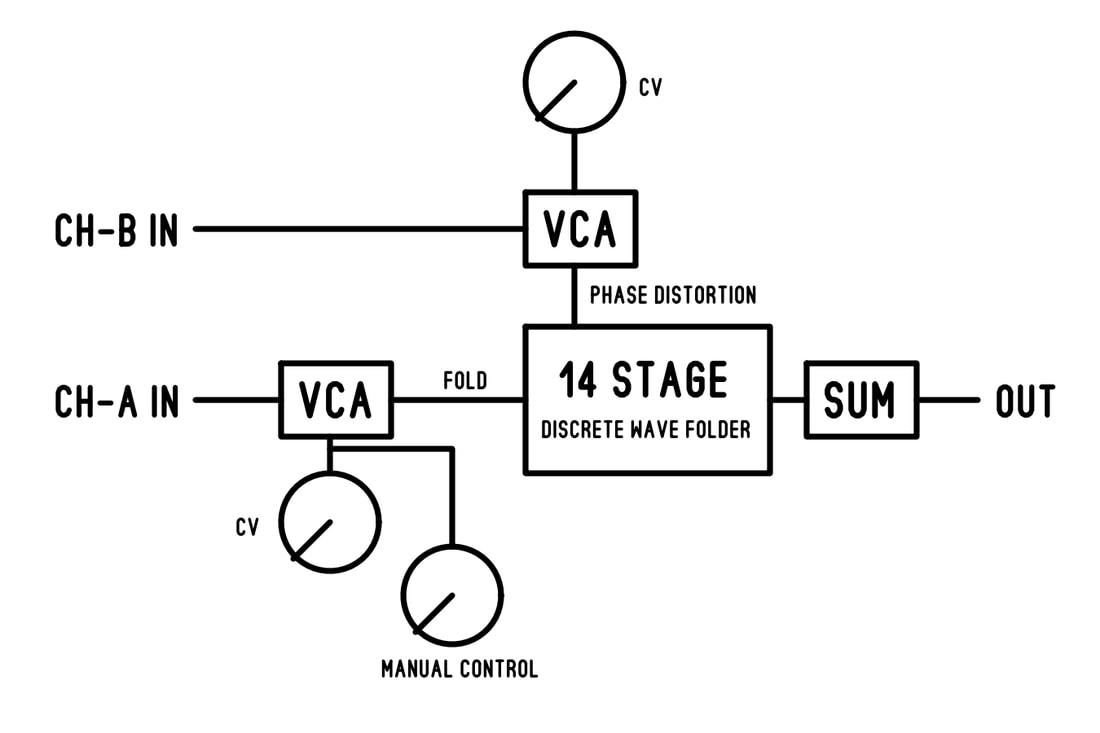|
MODEL: EURO 7HP SIMPLE DIGITAL ADSR v2.1
Envelope Generator Width: 7HP DEPTH: 1.5 inches CURRENT: +24mA , -13mA This module is an envelope generator. It offers Attack, Decay, Sustain, Release, and a 'time' knob to alter the length of the stage or 'loop'. You use this module to control other modules, for example: VCA's, VCO's pitch, Filter's. When in loop mode, the output is audible. Control Knobs: Attack, Decay, Sustain, Release, Time. Switches; Linear or Exponential mode. There is also a switch for Normal one pass, Gated mode, or Loop mode. Gated mode is like loop mode but it will only cycle with a gate signal patched up. Outputs: (2) simultaneous envelope outs. Inputs: (1) Gate or Trigger input, there is a passive thru jack for you to keep daisy chaining the gate patch to other envelope generator, (1) CV input with level CV knob to voltage control the envelope output level. Retail is $89.00 |
| blm-simple_adsr_v2.1.pdf | |
| File Size: | 869 kb |
| File Type: | |
|
Model: Simple VCLFO
Oscillator LFO Depth: 1.5 inches Width: 4 HP Current: +13mA, -13mA What does this do? This is another analog lfo made specifically for new clients who are on a really tight budget. I am offering a mini series called the 'Simple Series', which gives you the basics. So this particular module is good for modulating your filter module or vco module for example. Price: $89.00 |
|
Model: Mini Shimmery Module MK2
Percussive Metallic Generator Depth: 2.5 inches Width: 10hp Current: TBA Colors: Matt Black What does this do? There are 3 square wave oscillators that ring mod each other twice to produce 'shimmery' sounding tones or drones. The internal sound does not stop. When you patch from the 'drone' jack it is a constant sound. You use the A, B, and C knobs to tune each individual oscillator. Then you use the 'Tune' Knob to adjust all of the oscillators when you find that perfect sound. There is a TR influenced circuit that uses the abrupt dirty transistor vca to produce hi-hats or metallic percussion. I added the essential accent control to vary the amplitude. You need a gate or trigger signal from an lfo, etc, to activate the TR VCA portion of the module. Otherwise if you want clean hi-fi sounding percussion from this unit, you patch from the 'Drone' jack to your hi quality ssm2164, or cool audio v2164 vca. Price: $125.00 |
|
Model: Subharmonics Generator
Utility, VCO addon Depth: tba Width: 4hp current: tba Controls: 4 Knobs to mix in 4 divided sub harmonics. What does this do? This is a vco add on or helper. You patch a saw, square, triangle , or sine wave into the input jack. Now patch the output jack to a mixer module. For example you can use the Blue Lantern modules: Sir Mix Alot, Mix Em Up, or other third party mixers. You also patch one of the original waves from your vco (this is optional as you will still get audio results, it is just fun to mix the o.g. with the sub fat waves.) What you will hear with your gear is one supper fat mixture of harmonics. You have 4 knobs to mix in each harmonic. The module can handle a full wide frequency spectrum. The module is using CD4013 Flip Flop IC to do it's 4 divider break down. There is no latency, no Atmega or STM shenanigans. Take a look at the oscilloscope pictures. I sampled a saw wave, and square wave from a Simple Saw Core VCO and patched it into the Sub Generator module. knob 1: 7th note down from input knob 2: 7th note, 1 octave down from input knob 3: 1 octave down, from input knob 4: 2 octave down, from input. Still not convinced, did I mention it is $68.50? |
|
Model: Barton Duo Quantizer
Quantizer, Utility, Sequencer addon Depth: 1.5 inches Width: 4hp Current: +30, -26mA This is a quantizer based on the Michael Barton simple quantizer firmware PIC. There are two identical circuits found on this module. You can select two modes using the toggle switch. The 'Stand' mode is the standard mode which includes the follow scales: STANDARD BANK 1.Bypass - Inputted voltage is outputted 2.Major - Root, 2nd, 3rd, 4th, 5th, 6th, 7th 3.Minor - Root, 2nd, flat 3rd, 4th, 5th, flat 6th, flat 7th 4.Major Pentatonic - Root, 2nd, 3rd, 5th, 6th 5.Minor Pentatonic - Root, flat 3rd, 4th, 5th, flat 7th 6.Blues Scale Root, flat 3rd, 4th, flat 5th, 5th, flat 7th 7.Whole Tone - Root, 2nd, 3rd, flat 5th, flat 6th, flat 7th 8.Chromatic - All 12 notes The 'OCT' mode is the Octave BANK, which includes the following: OCTAVE BANK 1.Bypass - Inputted voltage is outputted 2.Octave - Root 3.Octave and Fifth - Root, 5th 4.Octave and Flat Fifth - Root, flat 5th 5.Major Arppegio - Root, 3rd, 5th 6.Minor Arppegio - Root, flat 3rd, 5th 7.Dominant Arppegio - Root, 3rd, 5th, flat 7th 8.Chromatic You use the knobs to select the different scales. Price: $110.00 |
|
MODEL: EURO FORMAT CMOS RING MOD MODULE
RING MODULATION width: 4hp depth: 1.5 inches Current: +40mA, -10mA Color: matt black This module is a ring modulation effect that is based on old arp odyssey circuitry with a twist. On the original it only mixed pulse waves internally. On my version you can adjust from pulse to triangular waves. Think of it like a tone control. Th operation of this product is easy. You patch any wave into "A" and another wave into "B". It is best to use separate vco's or noise sources tuned at different frequencies. You then hear the effect out of the bottom jack "cmos ring mod". Price: $75.00 |
|
Model: Millipede Variable Pole VCF MK2
Analog Filter, Can easily get Brutal tones. width: 13hp current: 58mA, -56mA Depth: 2.5 inches What does this do? This is an analog filter that uses two modern equivalent ssm2164 IC's v2164 from cool audio to do it's magic. This particular filter however allows the user to vary the phase of each pole or filter cell. There are four filter cells total. This is similar to the Blue lantern Asteroid Operator Station VCF. The Asteroid Operator Station VCF has 8 Static filter out puts. Those 8 flavors were found by exploring the circuit found on the millipede vcf and internally installing the resistor ratio for that flavor. On the millipede vcf you are allowed to find more exotic flavors yourself. Operation is easy. You first have all the poles counter clockwise and the three switches set to mute. This will have the filter as a dark Low pass filter. Then you turn on a pole using the switch and turn the know to hear the change. Pole 3 by default is always on, otherwise there would have been no sound if all poles were muted. Having all the poles set clockwise and active easily gets you into brutal sounding tones in a good way. There is an on board diode limiter circuit to help tame really harsh tones. This is activated by switch. The audio input has some gain, so you don't always have it fully clockwise. There is also a capacitor selector switch just like my other filters. This modifies the rez peak. Price: $250 |
|
Mode: BLM Dwarf Star Stereo Delay FX MK2
Width: 18HP Current: +81mA,-38mA Outputs: 1K Ohm, -5v/+5 Time CV: 68K Ohm, -5v/+5 Repeat CV: 100k Ohm, -5v/+5 Inputs: Expect -5v/+5 signals What does this do? This product uses two PT2399 Echo FX IC's to generate stereo echo processing. This particular FX chip is known to have a degraded 'flavor' in sound, when the timing is set to longer values. This new version will also allow you to dial in self oscillating feedback using the top 'Repeat' knob and 'FX' level knob. There is also a headphone monitor jack with level control knob. CV parameter: -individual Timing CV control of both channels -one input cv and single control for both 'repeating' circuits. This is basically the feedback path. -Trigger input CV for Bypassing the Wet FX. New Spread Parameter This parameter applies voltage to both delay circuits. But one voltage is inverted. This allows you to mess with both timings at the same time. There is also a level knob just for the spread parameter. Spread Knob is set too 12 o clock for 'off' position or zero volts. There is a new push button 'FX' parameter. You can use this feature in two modes: Momentary or Toggle. This parameter mutes the signal going into the Pt2399's input. So the delay trails do not get muted. This is good for live use. Nice Price! Price: $185 |
| blm-dwarf_star_stereo_delay-2020.pdf | |
| File Size: | 1934 kb |
| File Type: | |
|
Model: Buff
Active Multiple Width: 8hp Depth: 1.5 inches current: 5mA, -5mA What does this do? This module lets you repeat signals, or copy the signal. Channel 1 and 3 allow for 8 output copies. When you patch into the middle section you break the internal switch jack connection and allow for independent use of the bottom sections. Channel 2 has four outputs. Price: $80.00 |
|
Module: Stereo Sir Mix Alot 2020
Stereo Synth Level Mixer Current: +37mA, -37mA width: 24hp Depth 1.5", PCB Stack Level: 1 Channels: 6, with panning on each channel. Input gain: x10, synth level optimized. Output: synth level optimized. Since there are master level knobs, one can attenuate for line levels. Link ability: Yes, with 3.5mm stereo Y-cable. There is a jack labeled 'Stereo Link' where you can patch left and right synth level input signals. What does this module do? This module allows you to connect 6 channels of synth level Euro Format signals (-5/+5v) from your vco's or percussion modules. You then can pan left or right like normal desktop mixers. The final mixdown outputs are also synth level (-5/+5v). There are two send and returns which are also synth level (-5/+5v). There is no CV control of any kind. This is a basic stereo audio mixer. |
|
Module: FM Joystick Pro v3
voltage controller, lag processor Width: 12hp Depth: 32mm , 1.26 inches clearance Current: +23mA,-14mA Circuits: +/-5 volt outputs for each axis. Lag Processor and Rapid Trigger. When patched into the axis inputs, the circuit becomes an attenu-inverter. This is the 'FM' portion. This has a separate Lag Processor also. It will delay a gate, and create a lag rising slew controlled with the time knob. There is also a Rapid Trigger output, controlled by push button and rate knob. Price: $175.00 |
| blm-fm_projs-v3.pdf | |
| File Size: | 1631 kb |
| File Type: | |
|
Module: Accented Percussion Envelope Module (APE)
envelope generator, percussion, vca Width: 6hp Depth: 32mm , 1.26 inches clearance Current: +19mA, -32mA Circuits: Attack Decay Envelope Generator, and VCA's. What does this module do? This module allows you to add that dynamic 'accented' sound found in vintage gear like the Pearl SY-1 without having to build one of those kits, or hunt down the original. This module was influenced by such gear, but with modern parts. The goal was not to clone, but to get you really close results. -There is a vca on the envelope output (DEPTH) with it's own CV Level input. This Dynamic Envelope has it's own output to give external vco's a 'pitch' ability. To do Disco 'POW' for example. -There is another vca set up with CV Accent control just for the audio input. If you patch up a sequencer, you can get very close results to the DFAM envelope portion. *Gate or trigger input mode. *2 modes for envelope time: NORM, Perc (SHORT) Price: $93.00 |
|
BLM CMOS Clock Divider
The CMOS Master Clock Divider, from Blue Lantern, features four characteristically musical division stages: /2, /4, /8, and /16. Each section also features a phased output that allows for the delaying of trigger signals. There’s also a powered multiple that allows for accurate splitting of the signal with absolutely no loss in quality. The CMOS is extremely useful for triggering various events in a Euro rack modular synthesizer patch. Each output functions simultaneously, meaning users can out them to multiple sources for a variety of events. Additionally, each of the CMOS’s outputs can operate at audio rate as sub harmonic generators. CMOS Clock Divider Features Master Clock Divider Circuit 4 Main Division Outputs 4 Musical Division Sections 4 Phased Outputs per Section Powered Multiple Clock In/Thru Reset/Thru |
|
BLM Phase 4 Daze
Width: 16hp Current: +48mA -48mA What does this module do? This is an Audio Processor. It is an analog FX module based on the farfisa poly chrome phaser. You also get an onboard VC LFO with a specific Sinus Spike made just for phasers. The Phaser has the following CV controls: -VC Phase -Bi Polar Feed Back CV -Liner Modulation VC Phase The Onboard LFO has the following CV Controls: -Rate CV The module expects Synth Level signals, but line level signals can be processed somewhat. There is a bit of gain. |
| blm-phase4daze-phaser.pdf | |
| File Size: | 554 kb |
| File Type: | |
|
MODEL: BLM FM SINUS LAB
WIDTH: 10HP CURRENT: +36mA -36mA Module Requires additional modules to get the best out of it. Minimum 1 VCO with Triangle Waveform. What does this module do? This is a West Coast Analog Wave Folder, capable of doing through zero frequency phase modulation using the Phase B audio input. Input A is the 'Carrier', where the user patches a triangle wave or sine wave. Input B is the 'Modulator', where the user patches saw, ramp, square, triangle, or a sine wave form. To be specific, Input B is doing Phase Distortion. It is best to use two independent vco's. Input A and B have there own internal VCA with CV controls for both. You normally patch an Envelope generator to the CV inputs of these. You can also manually sweep the inputs to re-create the West Coast Sound. -14 Stage, 7 pair Wave Folder. -Discrete OTA design for each Folding Cell. -VCA input circuit for each input. -Zero Through Phase Modulation There is no other Wave Folder quiet like this one. This module easily beats the performance of the wave folder that came with your expensive complex dual vco module. You can easily create Mega Drive FM Big Boss sound effects. $165.00 |
